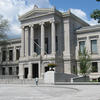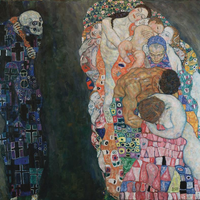More about Pictorial Quilt
- All
- Info
- Shop

Contributor
Pictorial Quilt by Harriet Powers is probably the coolest thing you could ever take a nap with.
Harriet Powers was a quilter born into an enslavement, who eventually owned land outside of Athens, Georgia after the Civil War. Very little is known about her, as records on African Americans were slim pickings at the time. Most of what we know about her is gathered from government documents, and historians believe she was illiterate, although she owned land and mortgaged it, even after she and her husband split up. Started around 1895, Pictorial Quilt was given as a gift to Reverend Charles Cuthbert in 1898, after being exhibited at the Nashville Exposition. Luckily, Powers’ own description and explanation of the scenes of this quilt still survive. Unlike her only other known quilt, Bible Quilt, this quilt contains both biblical and celestial references.
The quilt is enhanced with applique, which is when you cut pieces from one fabric and sew them onto the background of the quilt. Ten of the panels are biblical stories, and the remaining five either refer to astronomical events within the 100 year span of Powers’ birth, or represent community yarns (see what I did there?).
Many of the natural events and disasters portrayed in Pictorial Quilt predate Powers’ birth, which indicates that older relatives told her about these events. Their accuracy as proven by contemporary almanacs shows how dependable information from oral tradition was in the Black community, regardless of the alienation and forced separation they experienced at the time.
In her only known portrait, Powers’ apron has applique work on it, just as her quilts do, which portray celestial bodies and a cross. This consistent use of these symbols suggests that the cosmos were very important to Powers’ personal belief system. I wonder how Powers would feel about the booming crystal market right now, but given her clear badassery, I doubt she’d have the patience for it.
Neither of Powers’ quilts are the size of any standard bed at the time of their construction, and Powers herself described one of her quilts as a “Sermon in patchwork.” We can therefore understand Pictorial Quilt as an illiterate woman’s purposeful storytelling, each pane a scene uniquely designed for deeply personal and spiritual reasons. While many of Powers’ panes depict known biblical anecdotes, her quilts also serve as a record of oral tradition within her community, as exemplified by the patches that show events from before her birth.
Powers’ loved her quilts so much, that she often visited them after their sale. She also thought it very important to explain in detail what each panel of her quilt showed, and luckily those descriptions survive today. The quilt’s panels are numbered 1 through 15, starting at the top and going from left to right.
In this quilt, there are a couple of panels of Job, which if you haven’t brushed off your Old Testament for awhile, is a real hoot if you like the whole God testing you with unimaginable suffering. Of course, there’s some equally cheery squares depicting Christ’s life and some cute animal ones, referencing Noah’s ark for the faint of heart. Adam and Eve’s temptation made the cut too in panel 4.
Squares 2, 8, 11, and 12 are the most interesting, as they show astrological events, and a couple tall tales. Square 2, represents the “dark day”, May 19 1780, when Powers said the day was so dark, stars were seen at noon. Almanacs from the time confirm that this “Black Friday” as it came to be known happened in the Northeast U.S. on the date stated by Harriet. The stories about the event therefore traveled from the Northeast to Georgia, and the story survived accurately at least until Powers’ quilted this square in the 1890s.
Some historians believe that quilts were hung outside with clues for escaping through the Underground Railroad before the Civil War. Square 13 shows a couple “rich people were taught nothing of God” with a pig ‘Betts’ below them, who ran 500 miles from Georgia to Virginia”. This sow could be a reference to the older quilt use within the Underground Railroad, or represent Powers’ own eventual freedom.
Sources
- Cash, Floris Barnett. "Kinship and Quilting: An Examination of an African-American Tradition." The Journal of Negro History 80, no. 1 (1995): 30-41. doi:10.2307/2717705.
- Callahan, Ashley. "Harriet Powers (1837-1910)." New Georgia Encyclopedia. 01 October 2018. Web. 15 May 2019.
- Cole, Thomas B. "Pictorial Quilt." Jama 312, no. 19 (November 19, 2014): 1952-953. Accessed April 18, 2019. doi:10.1001/jama.2013.279853.
- Moreland, Jennifer. "Quilting: An Examination of Harriet Powers and Elizabeth Hobbs Keckley." (2012). https://digitalrepository.unm.edu/arth_etds/19
- Perry, Regenia A. Harriet Powers' Bible Quilts. Rizolli Art Series. Gordonsville, VA: St Martin's Press, 1994.
- "The Underground Railroad and the Secret Codes of Antebellum Slave Quilts." The Journal of Blacks in Higher Education, no. 46 (2004): 44. doi:10.2307/4133668.
- "Pictorial Quilt." Museum of Fine Arts, Boston. Accessed April 17, 2019. https://www.mfa.org/collections/object/pictorial-quilt-116166.















